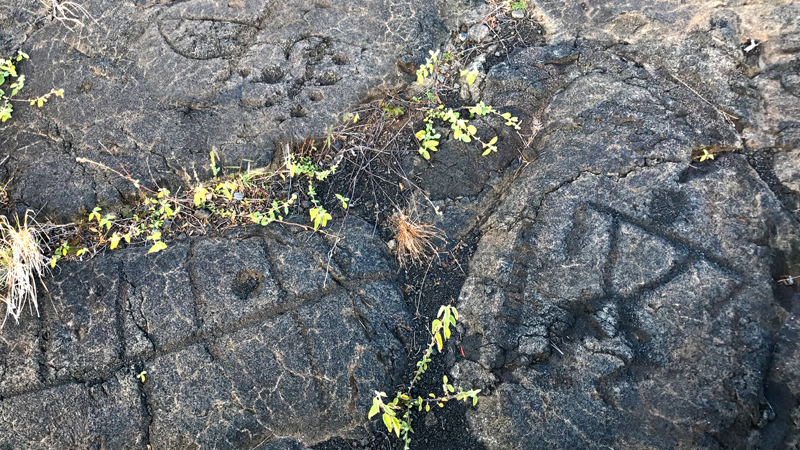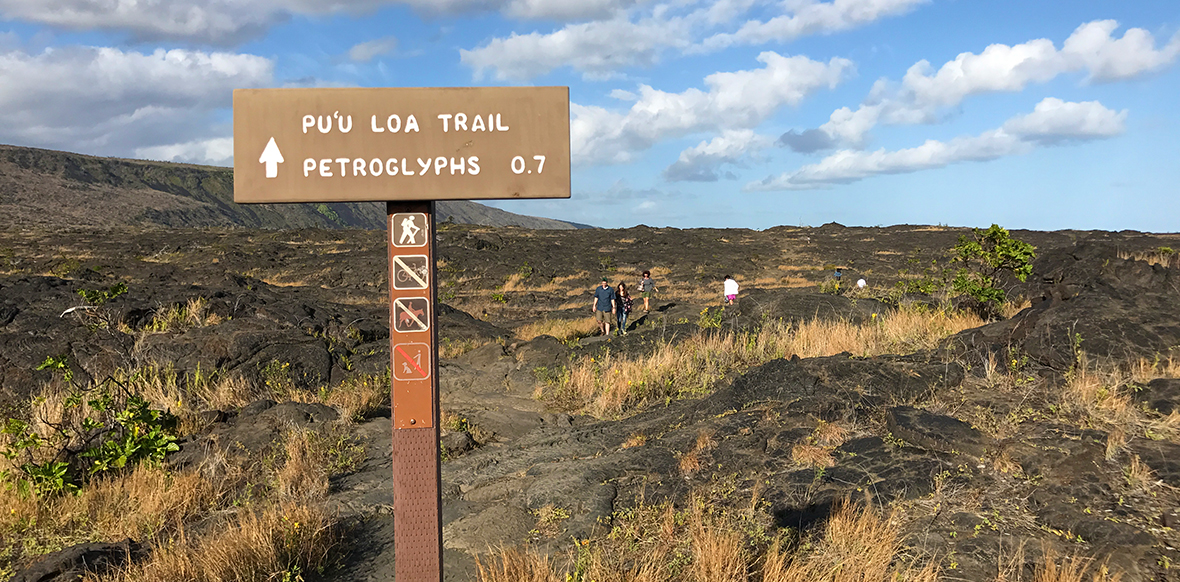
The last two activities of our first day in Hawai’i Volcanoes National park were hiking to the Pu’u Loa Petroglyphs and visiting the Hōlei Sea Arch. We we so excited for both of these activities partly because we all were a bit tired of visiting crater overlooks and partly because we had already visited two of the three petroglyph fields on the the other end of the Big Island earlier in our trip.
- The Puakō Petroglyph Archaeological District is on the grounds of the Fairmont Orchid Hotel and features 1,200 visible petroglyphs from a fenced viewing area.
- The Waikoloa Petroglyph Preserve on the Mamalahoa Trail is at the Hilton Waikoloa Village and provides examples of petroglyphs, lava caves, and stone windbreaks.
The Big Island of Hawaii has the highest concentration of ancient Hawaiian petroglyphs in the state and the Pu’u Loa Petroglyphs, dating back to 1200-1450 AD, is the largest of the three.

Pu’u Loa Trail
The Pu’u Loa Trail is a moderate, 0.75 mile, out and back hike (1.5 miles total) to an elevated viewing boardwalk in the middle of the Pu’u Loa Petroglyphs. This is a traditional Hawaiian Trail, which means you’re going to walking across the lava. The path to the petroglyphs is rocky, uneven, and slow-going. It’s also in full sun, which means it gets really, really hot on sunny days.
While this trail is flat, you’re traversing a 500-550 year old lava field and hearty grasses. Navigating the rough pahoehoe lava is work, so this is not a trail you want to hike in sandals or flip flops (which is what we did and we regretted it).
The Pu’u Loa Petroglyph Trail begins at the small sign near pullouts along both sides of Chain Of Craters Road. While the trail isn’t super clear, the path is marked by little rock piles called cairns. Carter was our trail leader and lookout, spotting the rock piles and keeping us moving in the right direction.
After three-quarters of a mile (which feels like a lot longer), a raised boardwalk appears to direct you through the Pu’u Loa Petroglyph field. The wooden boardwalk allows you to view the fragile, ancient stone carvings (ki’i pohaku) up close without damaging them or the sacred landscape around them.
Don’t be a jerk like one of the guys we saw during our visit. He had a big fancy camera and walked right off the boardwalk over the petroglyphs to take photos. This is incredibly disrespectful and this self-centered action can damage the carvings.
Pu’u Loa Petroglyphs
Pu’u Loa is a volcanic pressure dome formed 550 years ago during the eruption of Kāne Nui O Hamo. Dated between 1200 and 1450 AD, it is a religious Hawaii cultural location and has been used for scared rituals for more than 500 years.
With more than 23,000 stone carvings, the Pu’u Loa Petroglyph field is known as the hill of long life and is one of the most extensive petroglyph fields in Hawaii. The petroglyphs document the life of native Hawaiian people and include pukas, circles, geometric designs, human figures, hooks, canoe sails, starfish, and other designs.
The design of concentric circles with a small depression in the middle was used in spiritual rituals where pieces of a newborn’s umbilical cord was placed in the center hole to pray for blessings of a long and prosperous life.
Know Before You Go
- The Pu’u Loa Petroglyphs are located 6.4 miles from the Kealakomo Lookout, 16.3 miles from the start of Chain Of Craters Road, and 19.6 miles from the Kīlauea Visitor Center on Chain Of Craters Road in Hawai’i Volcanoes National Park.
- Pu’u Loa means long hill or hill of long life.
- Trail begins at Pu’u Loa Petroglyphs parking area, which is simply a wide pullout along the side of Chain Of Craters Road.
- Stay on the boardwalk and be mindful that this is a scared and religious place. The petroglyphs are delicate. Do not touch or make rubbings as it damages the carvings.
- Bring water, food, a hat, and sunscreen, wear sturdy tennis shoes or hiking shoes, and be prepared for hot, dry, windy, and rainy weather.
- Visit in the early morning or the evening or on an overcast day for the best views — the direct overhead sun mid-day can make it difficult to see some of the carvings.
- The closest restrooms are vault toilets at the Hōlei Sea Arch.











